


Melissa Omand, physical oceanographer, collaborated with Kirsten Carlson, Artist at Sea participant, to create a watercolor explaining the linkage involved in the Wirewalker’s whole assemble.
I have sailed with my share of compelling characters since I began ocean research, and perhaps it is fitting that while we study ocean color aboard the R/V Falkor, I have had the pleasure of getting to know one of the most colorful. Kirsten Carlson has joined the cruise as an artist-in-residence, bringing her zany, insightful perspectives and boundless energy to coax us from our laptops. Last night she encouraged me to try out her Artscipaedia Plankton coloring booklet. That is right – plankton – as in the microscopic organisms that color the ocean… exactly what the scientists are studying onboard. As it turns out, Kirsten has a background in marine science, and is a self-described plankton rescuer!
While coloring, I found my thoughts drawn back to the instrumentation I had released over the side the day before. My Wirewalker and sedimentation traps were miles away from our ship, drifting in the open ocean, collecting data and doing their thing… I hoped. I decided to draw the Wirewalker instrument array. I have spent months preparing for this cruise – testing the sensors, communications, preparing the sediment tubes, and making sure each piece of hardware is accounted for. I discovered I knew it by heart. Kirsten shared her watercolor paper and we devised a plan to collaborate – I would draw and she would paint. I can’t recall finding such catharsis on a cruise before. As the rest of our science party started a movie in our de facto hang-out space – alibrary/office/lounge/video conference room that has quickly become the center of orbit onboard the ship – I did my best to dust off an artistic identity I’ve rarely assumed since I was a visual art major in in high school.
Drawing the mundane but critical details of each linkage in the array, I newly appreciated the elegant design of the Wirewalker: a design evolution I had observed since shortly after its invention by Dr. Rob Pinkel’s group at Scripps Institution of Oceanography. The Wirewalker is assembled in distinct segments. At the top, is a GPS-tracked buoy, and beneath this hangs a 3/16” stranded wire that stretches 150 m beneath the surface. As the buoy tugs the wire up and down over the waves, the sensor-laden Wirewalker uses a simple cam mechanism to rectify the wave action into a one-way motion down the wire. When it reaches the bottom, it hits a stop and releases it’s grip, gliding freely along the wire to the surface. This cycle is repeated every 10 minutes or so, giving us a remarkable high resolution view into the physical and physiological variations of the plankton and particles in the upper ocean.
Having a professional artist on-board (in addition to a number of talented crew and fellow scientists) has been a unique experience and has inspired me to reconnect with my inner artist. As I write this, I only hope that our collaborative art is an homage, and not an obituary to my lonely Wirewalker adrift amongst the enormous waves of the wintery North Pacific Ocean.
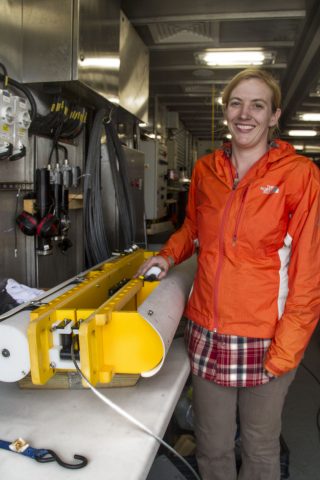
Melissa Omand will be working with Meg Estapa and Colleen Durkin to study the data collected by the Wirewalker’s assemble in order to understand Carbon Pump in these waters.
Researchers in the Dry Lab are able to examine the most recent Virtual Reality simulations created from holographic photos taken in each CTD cast. With this experience, it is clear that every single drop of water in the ocean contains huge amounts of life. Microscopic organisms constantly carry out processes that maintain the atmosphere, air, food webs, and life as we know them. Yet humans are changing things quickly, and we do not have enough knowledge to determine what our future world may look like. Hugo Berthelot, biogeochemical oceanographer, is on Falkor to fill in some of the blanks.
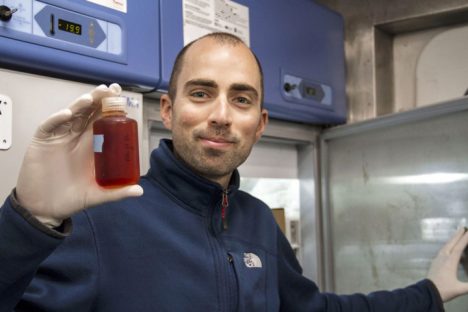
Hugo Berthelot, biogeochemical oceanographer, is on Falkor studying phytoplankton organisms and the biochemical processes they take part in.
Who is Doing What?
One crucial aspect of microbial communities that researchers want to understand can be summed up in the cheeky question “Who is doing what?” This is important to understand because of the delicate connections between all marine and terrestrial life, granting us a start to inferring the microscopic “winners” and “losers” in the face of Climate Change.
To do so, Hugo is studying the Nitrogen Cycle. Nitrogen is a key nutrient at the very base of the food chain, both on land and in the ocean. Its availability directly impacts the global marine ecosystem. Many microorganisms feast, grow, and live off of it. Once the microorganisms reach a certain size (or die), they will sink, dragging carbon – in the shape of organic matter – down with them. Once carbon leaves the superficial layers of the ocean and enters deep waters, it will be gone for thousands or even millions of years. As it stands today, a healthy functioning carbon sink is probably good news. This carbon pump has been working for thousands of years, helping regulate the Earth’s chemistry and temperature.
Understanding how available Nitrogen is for microbes to feed on, along with how different organisms are able to transform Nitrogen after they have ingested it, directly relates to the inner-workings of the biological carbon pump, Hugo’s main focus of research. He will collect water samples in very different geographical locations and weather conditions as Falkor sails from Hawaii to Portland, Oregon.
Invisible Gases and Microscopic Beings
Phytoplankton is very, very small. Studying which microscopic organisms transform an invisible gas (such as Nitrogen) and their rates at doing so is extremely challenging. Therefore, Hugo utilizes a special technology called nanoSIMS, but before he gets to that point, he must follow certain steps.

Using an incubator, Hugo Berthelot enriches the water with Nitrogen and exposes the microorganisms to this environment for 24 hours, to later assess how much Nitrogen each cell consumed.
He first collects water samples from the surface and from Niskin bottles deployed in CTD casts at the Deep Chlorophyll Maximum depth of 150 meters. The, using an incubator, he enriches the water with a stable form of Nitrogen (N15) while maintaining the microbial communities natural conditions, including light and temperature. After a day of incubation, he filters the water and freezes the samples, hence preserving each organism. Once back ashore, flow cytometry cell sorting will enable him to identify each kind of cell and sort them into taxonomic groups. Then nanoSIMS technology will detect the amount of N15 consumed by each cell. After months of rigorous and complex analysis, Hugo will be closer to understanding which organisms are carrying out certain chemical processes, as well as which ones are likely to benefit from changes in global climate.
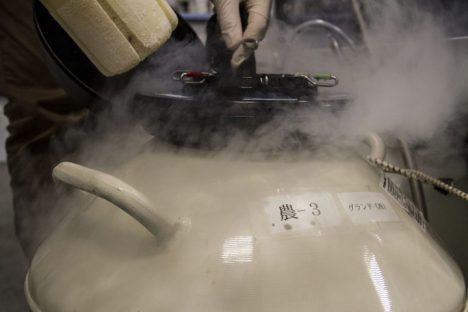
Hugo freezes the filtered samples using liquid Nitrogen. After leaving Falkor, he will analyze the cells to understand which chemical processes each one carries out and how they responded to the incubator experiment.
Every microorganism specializes in one single task, transforming one chemical element into another and fuelling our planet’s biochemical system. Therefore, changes in microbial populations will inevitably affect Earth’s chemistry. Once the snowball of a changing climate has begun rolling, it will trigger other factors – such as changes in oceanic microscopic ecology – which will in turn add to the snowball’s speed and impact. Figuring out what life inside a drop of seawater may look like in the future is essential knowledge for researchers to understand what the future may hold.

This is my instrument, which is designed to measure dissolved gases in seawater to detect the oxygen produced by algae. Sea Sparkle, my trusty green stuffed plankton assistant, is keeping a careful eye on the data we’re collecting!
When people think of science, the first examples that come to mind are often dramatic triumphs—the moon landing, the invention of DNA sequencing, or the discovery of the polio vaccine. Almost every exciting experimental result, however, is the result of an enormous amount of unseen effort. Thorough preparation, resourceful improvisation, success and failure, and improvement through trial and error are all deeply familiar to any researcher!
At sea on the Falkor, the challenges that we face as a part of ocean science are unique. After all, any unanticipated problems must be solved using only the resources on board our two-hundred-foot vessel.
Our first two days at sea have presented their fair share of challenges. Our cruise plans have changed almost daily in order to adapt to weather patterns and the ship’s limits in terms of speed and range. In the “wet” lab, anywhere from six to eight science team members must work elbow-to-elbow with all of their equipment packed into a space little larger than an examination room at the doctor’s office.
For my research, which involves measuring dissolved gases from seawater to detect plankton activity, plumbing has been my biggest enemy so far.
The seawater I am measuring is piped continuously aboard ship via a pump, and this water is available from only two outlets in the already-crowded lab. My original plan to use seawater from one of the two faucets was scuppered when a crucial valve broke, spraying the lab with ocean water like a fire hose! After shutting the faucet and confirming that none of our sensitive electronic instruments had been damaged, we realized that I would now have to take my water from the second outlet—located on the opposite side of the room from where I had set up my seawater supply tubing…! In addition to reorganizing all of my plumbing, I would also have to find materials to connect to the second faucet, which uses a different connection from the first.
Luckily, scientists can be pretty inventive! My seawater supply pipe was moved to hang from the ceiling in order to cross the room, and I borrowed parts from other members of the science team in order to fit my tubing to the new faucet. Sharing the lab space is also an important part of ocean science, and so Ryan, another scientist on board, graciously moved some of his equipment to give me access to the faucet.
When doing science at sea, it’s also important to learn from mistakes and bad luck quickly. This time, we fitted double metal clamps to the faucet connection to reduce the risk of unleashing a second fire hose event. With that final step, my plumbing was finally usable, allowing me to switch on my instrument and start collecting my valuable data!
In the end, we spent several hours fixing this incredibly boring problem—one which has very little to do with actual science. Paradoxically, however, all of our tinkering with tubes and faucets was essential in order to perform my research. This is just one of the many small challenges that we have dealt with as we prepare for one of the busiest parts of our expedition. Even though many of our problem-solving stories will never be mentioned when we publish our research results, they are just as much of a part of our science as designing experiments or picking locations for the Falkor to explore.
It’s little challenges like this that help me remember that every scientific discovery, great or small, is built on a huge foundation of invisible work!

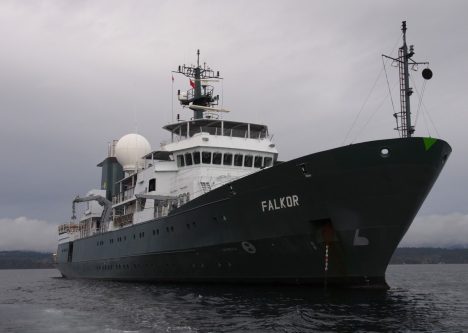
Research Vessel Falkor. Credit: Schmidt Ocean Institute
In just two short weeks I’ll be trading the cold, snowy beaches of Rhode Island for the warm, tropical beaches of Hawaii. Such is the life of an oceanography graduate student!
Although I do enjoy traveling and discovering new places, what’s most exciting is that I’ll have an entire month to conduct my research in the Pacific Ocean alongside some of the top scientists in optical oceanography. Together we’ll be looking at particles in the upper layers of the ocean during the Schmidt Ocean Initiative’s Sea to Space Particle Investigation aboard the R/V Falkor.
So what exactly will I be doing while I’m in the middle of the Pacific Ocean? Here are my top three activities at sea:
Going to sea is a lot like being at a high-end summer camp—someone cooks your meals and does your laundry while you spend almost all day engaging in an exciting stream of team activities. It’s a very social experience with many late night hours talking science and scheming the next experiment all while working on the most urgent area of science: climate change. I couldn’t be more excited.

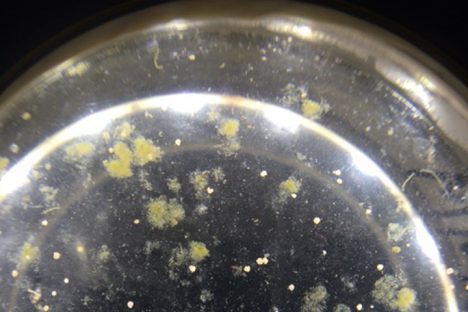
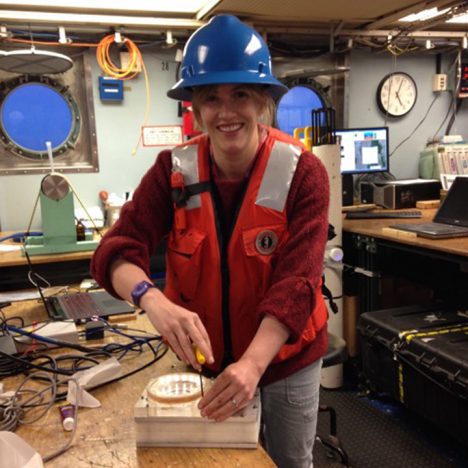
Update: The R/V Endeavor returned from sea on Aug. 6, concluding the fieldwork component of the 2014 SABOR experiment.
As mentioned in the previous blog (“A Vast Ocean Teeming with Life”) ending this cruise is not an easy thing to do. Especially if you experienced the majesty of the crystalline blue water in the open ocean as well as the magnificence of the wildlife surrounding it for the very first time. I am currently coursing my third year as a PhD student in the Electrical Engineering Department of The City College of New York (CCNY). I work as a research assistant for a small department in the Optical Remote Sensing Lab called Coastal and Oceanic waters group. We may look like a group of cool guys going out for fishing (as it seems on the left side of the picture), however, we are a team who works hand to hand together (depicted on the right side of the picture … why does the right side always seem right?)
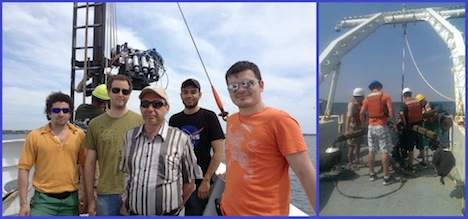
“Cool guys” aka Coastal and Oceanic waters group, members of the ORS Lab at The City College of New York (CCNY). Courtesy of Lynne Butler
My research consists of using polarization properties developed as the light field propagates through the water body and use this information to characterize and retrieve water constituents and inherent optical properties (also called IOP’s) from polarimetric measurements. The basic idea is that as light propagates through the water it experiences significant attenuation due to absorption by water and suspended/dissolved matter as well as scattering by water and suspended particulates. These effects, both absorption and scattering, result in signal degradation of the radiance captured by sensors in our instruments. The additional information obtained when using polarization properties of underwater light propagation can provide a better understanding of this propagation and methods for improving image quality and increase underwater visibility … wait! (at this point you may be asking yourself).
So how can this have a real contribution to the goals and objectives pursuit by the SABOR (Ship-Aircraft Bio-Optical Research Campaign) cruise? Well, the answer could be very simple. The ocean is too big and in-situ measurements are too expensive to cover the entire water mass on Earth. Having this in mind, it is very clear that we need to adopt another cost-effective approach and that is the reason why we use satellite observations to account for many changes that take place in the ocean and coastal waters. Satellites provide very useful information when properly calibrated. As you may already know, sensors deteriorate over time and satellites go out of commission. However, polarization features are preserved even when the sensors may have experienced normal degradation and knowledge of this features can contribute in the development of future technologies to be used in satellites when more accurate and reliable information is to be acquired. Some living and manmade objects in water have partially polarized surfaces, whose properties can be advantageous in the context of target camouflage or, conversely, for easier detection. Such is the case for underwater polarimetric images taken to detect harmful algal blooms (red tides) or to assess the health of marine life and coral reefs which are of significant scientific and technical interest.
The main challenge faced by these images is that of improving (increasing) the visibility for ecosystems near and beyond the mesophotic depth zone. Data collected in the form of images, videos and radiance was acquired using a green-band full-Stokes polarimetric video camera and measurements of each Stokes vector components were collected as a function of the Sun’s azimuth angles. These measurements are then compared with satellite observations and model using a radiative transfer code for the atmosphere-ocean system combined with the simple imaging algorithm. The main purpose of this task is to validate satellite observations and develop algorithms that improve and correct these observations when needed.
It always looks like I am playing video games but in order to have very accurate information it is advisable to position the instrument at a certain orientation with respect to the Sun’s azimuth angle. The instrument depicted here is called Polarimeter and as Robert Foster suggested in his blog it has a very boring name, so we are still in search of a cool code name after someone suggested (unsuccessfully, and I am glad for this) to call this instrument Carlos. A real issue came across when they were thinking to put Carlos in the water … an idea that I didn’t share. The polarimeter, let’s forget about Carlos for a moment, is a set of Hyperspectral Radiance sensors with polarizers oriented in the vertical, horizontal and 45° from a reference axis. This sensors can capture light coming from any point in the water body thanks to a combination of a step motor which can be programed to stop in any sequence of angles in the range of 0 – 360° (from vertically up to vertically down) and a pair of thrusters (or propellers) which can rotate in the azimuthal direction (both clockwise and counter-clockwise). This scenario allows for vitually a 3-D range of hyperspectral measurements. Pretty cool, huh? The set of bouys at each corner allows us to have a very stable system and prevent the instrument from going very deep down in the case that cables and safety line get cut.
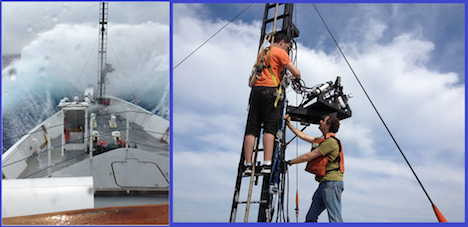
When things go like they do in the left image, we always have to do the right thing. Courtesy of crew members and Ivona Cetinic
Very far from what most of us have probably experienced in a cruise or fishing trip, the ocean is not always calm. In our twenty plus days in the ship, we came across a system which was playing very rough against the R/V Endeavor. Fortunately for us, this cruise was under the supervision of very talented and experienced people. I am not talking only about the captain, but also his outstanding crew members, chief scientist and marine technician. Although we have some minor difficulties (… you should know by now that sea water and electronics will never be good friends) we fixed them as soon as the storm was gone. It is not that Robert and I are playing as firefighters rescuing a dispaired kitten from a tall tree.
I want to end my vision of this field campaign with a summary of the awesome marine wildlife that somehow approach to us to say hello, some species more shy than others, to this group of scientists which were part of NASA-SABOR. As depicted in the picture (left-to-right and top-to-bottom), one of the first appearences was that of a seagull. It doesn’t look that shy since it preferred posing for us on top of the Polarimetric Lidar (owned and operated by scientist from NRL). Very intelligent creature this particular one, the others were just swimming in the waters and preparing to be a snack for a hungry shark as depicted in the image in the top center. Another interesting character which showed up near the surface was previously mentioned by Matthew Brown from Oregon State University in the previous blog post and it was a species of blueish salp with very long tentacles. The next creature is a very friendly dolphin which pretended racing us so we could take very amazing pictures. Dolphins always so adorable, appearing in pods and jumping out of the water around the research vessel or just posing underwater in front of the polarimeter! The last living character was a very shy sperm whale. Always keeping the distance but letting us know it was present leaping out of the water at most 300 feet from the ship!
These past three weeks in the R/V Endeavor had been very amazing although intense. Waking up and knowing that you are far from home, your friends and family may sound questionable but understanding that you are in front of one the most wonderful and powerful sources of life is a priceless experience not all of us can witness. That is why I am writting this blog and I hope you have enjoyed reading all our blogs and could have a taste of what is like being in the sea for three weeks!